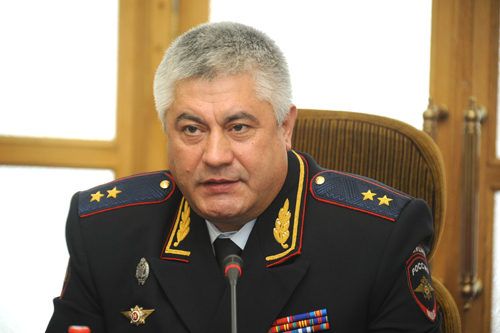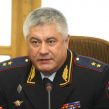
Moscow and Grozny Continue to Play Down Chechnya’s Persistent Insurgency
Publication: Eurasia Daily Monitor Volume: 9 Issue: 196
By:

While on a visit to Chechnya on October 15, Russian Interior Minister Vladimir Kolokoltsev held a meeting with the Russian Interior Ministry police chiefs of the North Caucasus Federal District and the joint command of the Interior Ministry’s troops (www.kommersant.ru/doc/2045606/print). Kolokoltsev was preparing to deliver a report in Moscow. Last August 16, Kolokoltsev reported to Russian President Vladimir Putin on the results of his visit to the North Caucasus. Federal Security Services (FSB) Director Alexander Bortnikov and Deputy Interior Minister Nikolai Rogozhkin, who is commander of the Interior Ministry’s troops, were also present at the meeting (www.cntv.ru/2012/10/17/ARTI1350436477026300.shtml). Putin explained that with the high numbers of militants who were killed and arrested, the army’s participation in special operations against the rebels was seen solely as a means of coordinating various agencies and no more than that (www.ria.ru/defense_safety/20121016/903011630.html). Putin also made another important statement, saying that the upcoming big events in the country should be well-protected from terrorist attacks (www.yuga.ru/news/275861/), apparently referring to the Olympics in Sochi in 2014.
A speech given by Ramzan Kadyrov on October 17 very much followed in Putin’s footsteps. The Chechen leader stated that to resolve the issue of extremism, the government needed to ratchet up work on the spiritual and moral education of youth, in order to explain to young people the dangers Wahhabism and extremism pose to society. Kadyrov said that in order to convince young people, government workers needed to back up their speeches with ayats and hadiths from the Koran (www.grozny-inform.ru/main.mhtml?Part=8&PubID=37257). Thus, Kadyrov offered a kind of alternative approach to the armed fighting in the region, something that must have been agreed on with Moscow, whose analysts on the North Caucasus are not always good at realistically assessing the situation in the region.
For example, Kadyrov asserted that there has not been a single terrorist attack in Chechnya in 2012 and that, “according to various sources, the number of militants might comprise 35–40 people.” This ignores the suicide bombing near a military shop in Grozny on August 6 that killed four and injured another three servicemen (www.km.ru/v-rossii/2012/08/06/vzryvy-i-obnaruzhenie-zalozhennykh-bomb-v-rossii/v-rezultate-dvoinogo-terakta-v-). What do they call a terrorist attack in Chechnya, if even a suicide bomber’s attack does not qualify as one? Furthermore, the figure of 35–40 militants has been in place now for the past seven consecutive years. Each of those years, the number of killed and detained rebels exceeded this figure by three or four times. At the end of 2006, one of Kadyrov’s closest associates, Adam Delimkhanov, stated: “There are about 60 militants and 20–30 foreign mercenaries left in the mountains” (www.kavkaz-uzel.ru/articles/chechnya_pobeda_nad_boevikami). After less than a year, at the beginning of 2007, Kadyrov stated that the separatists in Chechnya had suffered utter defeat and that by the end of the year there would not be one rebel left in the republic (www.kavkaz-uzel.ru/articles/chechnya_pobeda_nad_boevikami). At the end of 2006, the Russian news agency RIA Novosti estimated there were about 700 militants in Chechnya (www.memo.ru/2007/05/02/0205071.html).
On January 30, 2008, during an Internet conference, Kadyrov reassured the public there were no more than 60–70 “demons” left in the republic (www.i-r-p.ru/page/stream-event/index-19092.html). On July 8, 2009, Kadyrov noted that “in Chechnya there are no more than 50–70 rebels, over half of whom are foreign mercenaries who were trained by the Western security services” (www.islamnews.ru/news-19509.html). On October 22, 2010, the estimate of the number of militants totaling between 50 and 70 was repeated again (www.newsland.ru/news/detail/id/575725/). Yet, 80 suspected rebels were killed and 166 more were arrested in Chechnya in 2010 (https://chechnya.kavkaz-uzel.ru/articles/179709/)—a total four times more the number of militants who were supposedly left in the republic. On December 31, 2011, an official statement said “multiple operational sources testify to the number of militants being no more than 50 people” (www.bbc.co.uk/russian/rolling_news/2011/12/111231_rn_kadyrov_chechnya_militants.shtml). Yet, sources in the Interior Ministry reported that 131 militants were killed in Chechnya in 11 months of 2011 (https://lenta.ru/news/2011/11/21/insurgents/), which is three times more than the number used by Kadyrov.
Even the prosecutor general’s office in Chechnya was forced to start paying attention to the police’s inconsistent statistics. The office accused the republican Interior Ministry of rigging the number of crimes that were committed in Chechnya. According to the prosecutors, the police registered crimes whose statute of limitations had passed or whose participants died (www.yuga.ru/news/276158/). They accused the republican Interior Ministry of registering the voluntary surrender of weapons, including non-functioning weapons, as crimes. This type of rigging of statistics is reportedly a regular practice in Chechnya. The republic’s interior minister, Police Lieutenant-General Ruslan Alkhanov, ordered his subordinates to stop this practice and streamline the crime registration process (www.grozny-inform.ru/main.mhtml?Part=8&PubID=37325).
It was also interesting to learn from the Chechen Interior Minister that “all units of the Chechen Interior Ministry, the Interior Ministry troop regiment named after Akhmat-Hajji Kadyrov, [and] the Yug battalion are involved in the Kavkaz 2012 exercises” (www.yuga.ru/news/275883/). This statement contradicted the Russian authorities’ official announcement that the armed forces from Chechnya would not participate in the exercises (www.vestikavkaza.ru/news/Minoborony-Rossii-otkazalos-ot-provedeniya-ucheniy-Kavkaz-2012-vblizi-Gruzii.html). The military had said that the decision to stop using Chechen forces was made to avoid a nervous reaction in Georgia, where people feared another round of events along the lines of the August 2008 war, such as a Russian military incursion into the country. However, now it turns out that Chechen Interior Ministry troops that specialize in carrying out operations against the armed resistance in the North Caucasus were involved in the exercises.
Thus, in Chechnya, as well as in other republics of the North Caucasus, the government gives priority to confronting followers of Salafi teachings with arms. Yet it appears that new people, most of them young, are replenishing the ranks of those perpetual “several dozen” militants who are carrying on the struggle with the government until victory.




